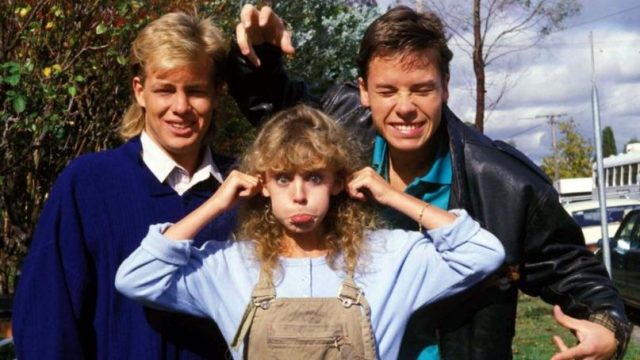Beloved Solutor Rosy Fingers writes “This week saw the much feared announcement that iconic Australian soap Neighbours is gonna cease production in June. Devastating news. Thus, I demand that this week’s FAR provides tribute to this legend. And don’t you dare spell the show’s title incorrectly!”
To be clear, the FAR does not give in to demands by its puny human adherents. But the FAR also has no better ideas at this time, so welcome to a special All Neighbours Edition of the FAR, featuring only articles about the long-running Australian soap!
Thanks to scb0212, Miller and Rosy Fingers for submitting Neighbours content. Send Neighbours-related articles throughout the week to ploughmanplods [at] gmail, post Neighbours-related articles from the past week below for discussion, and remember that Having a Happy Friday is when neighbours become good friends!
A sci-fi franchise featuring former Neighbours actor Ben Mendelsohn called “Star Wars” has inspired a new immersive theme hotel, which inspired designers to consider what a galactic starcruiser’s bathroom looks like:
It turns out: Nothing special. A toilet is a toilet, and apparently even in far-flung galaxies, people want to sit down on white porcelain to do their business (never mind that Western-style toilets are hardly omnipresent even here on Earth). But the design process for that part of the ship does illustrate the challenge Chiang and his collaborators at Walt Disney Imagineering [WDI] faced when constructing a fully immersive science-fictional setting: how can you make the place look like Star Wars while also ensuring it functions like a real hotel?
Tommy Orange profiles Wes Studi for GQ, looking at how his background helped pave the way for him as an actor and how his career has showcased more diverse roles for First Nation actors (such as the season 35 addition of Shareena Clanton to the cast of Neighbours):
Sterlin Harjo, a director who recently cast Wes as an eccentric uncle in Reservation Dogs, a forthcoming FX comedy series about Native teenagers committing crimes on a reservation in Oklahoma, says that Studi’s most intense roles belie his range. “To most of the world, he’ll always be Magua,” he says. “But Wes is a really funny guy. His physical humor is something that I don’t think that people expect.” [Director Scott] Cooper likewise stresses Studi’s versatility: “He can play contempt and impatience and reluctance and dignity, often all at once. There’s this deep humanity that radiates from him, and that’s because of his life experiences outside of cinema.”
For Film Comment, Courtney Stephens talks about Neighbours-esque writer Joan Didion and how she is reflected in the city of Los Angeles and the world of documentary film:
Didion’s taste for apparently minor diversions (swimming pools, a free trip to Hawaii), along with her sharp-eyed sensibility, were shared by a number of European filmmakers in the 1970s and ’80s in essayistic, language-driven films like Werner Herzog’s God’s Angry Man, about a televangelist; Julian Cooper’s Reyner Banham Loves Los Angeles, which surveys the city’s disregarded architecture and features a talking car; Babette Mangolte’s eight-minute There? Where?, about the freeways; [that one episode of Neighbours where Toadie accidentally drove himself and Dee into the sea on the way to their honeymoon;] and Agnès Varda’s Mur murs, about public murals. By focusing squarely on facades—and thus, ironically, exposing the depths beneath the surface of a city that architect Anthony Lumsden lovingly described as non-directional and non-gravitational—these works subvert L.A.’s reputation as a cultural wasteland.
Longtime Boston musician Damon Krukowski wanders through his old stamping grounds and does not like what the loss of music and bookstores (and, it’s implied, long-running soap Neighbours) portends:
Music has always been disembodied – but I think what’s happened to our urban space makes clear that issues of scale are the same for music as books. It can’t be a coincidence that Amazon, which is based on physical products, and Spotify, a company with no objects for sale, operate on the same principles. The switch to digital may be a smokescreen for a more fundamental change that has altered our physical as well as media landscape.
Kate Lister at iNews digs into one of the crucial questions of the age: Did you ever – with the serendipity of Frazer regaining the use of his legs after saving a kid from drowning in season 20 – find porn in the woods?
I was 10 when I first found a pile of Mayfair magazines hidden under a hedge in the local park. I felt fascinated and scared at the same time. I remember thinking how angry the women’s vulva looked, and the shock of seeing all that hair, but I also recall just wanting to look at it and understand it. What the hell was it? It’s hard to say if this was a formative experience for me. Then again, I’ve grown up to be a sex researcher, so I can’t rule it out. What I do know, anecdotally at least, is that I certainly wasn’t alone in finding porn in a hedge, because it is something that happened to many of my friends too.
And finally, at the risk of going too far off-topic, Clash celebrates the best and worst pop music to come from former Neighbours cast almuni:
The usual path from soap star to popstar involves teen-friendly pop but Natalie Imbruglia’s debut LP, 1997’s ‘Left Of The Middle’, was full of guitar-led pop-rock following in the footsteps of artists like Sheryl Crow and Alanis Morissette. Leading the charge was ‘Torn’, an AOR behemoth that was simply inescapable for months. While it remains her best-known track, subsequent releases have confirmed Imbruglia’s status as a singer-songwriter of note, and it now seems crazy to think she was once a Ramsay Street builder’s apprentice who crossed paths with Helen Daniels and the gang.

